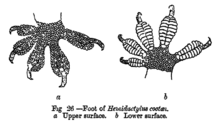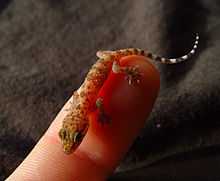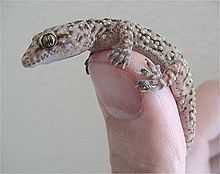Hemidactylus
| Hemidactylus | |
|---|---|
 | |
| Mediterranean house gecko, Hemidactylus turcicus | |
| Scientific classification | |
| Kingdom: | Animalia |
| Phylum: | Chordata |
| Subphylum: | Vertebrata |
| Class: | Reptilia |
| Order: | Squamata |
| Suborder: | Gekkota |
| Family: | Gekkonidae |
| Genus: | Hemidactylus Oken, 1817[1] |
| Type species | |
| Gecko tuberculosus | |
| Diversity | |
| Around 90 species, and see text | |
| Synonyms | |
|
In alphabetical order:
| |
Hemidactylus (the house geckos) is a genus of the family of typical geckos, Gekkonidae. It has about 90 described species, newfound ones being described every few years. These geckos are found in all the tropical regions of the world, extending into the subtropical parts of Africa and Europe. They excel in colonizing oceanic islands by rafting on flotsam, and are for example found across most of Polynesia. In some archipelagoes, cryptic species complexes are found.[2]
They are typically known as house geckos, due to their readiness to adapt to and coexist with humans. This genus was originally established by Lorenz Oken in 1817 for the species at that time known as Hemidactylus tuberculosus, and now described as the tropical house gecko (Hemidactylus mabouia).[2]
Feces
A house gecko will usually confine its excretions to one area of a house. This is sometimes considered a nuisance by home owners, and may stain certain surfaces.[3] The feces are approximately five (5) millimeters in length, two (2) millimeters wide, and dark brown (almost black) in color.
Description

The dorsal lepidosis is either uniform or heterogeneous. The pupil of the eye is vertical. Males have pre-anal or femoral pores. Each finger or toe has a slender distal clawed joint, angularly bent and rising from within the extremity of the dilated portion.[4]
The fingers and toes are free, or more or less webbed, and dilated; underneath they bear two[citation needed] rows of lamellae in a pattern resembling a paripinnate compound leaf.[4] This leads to their other and more ambiguous common name, "leaf-toed geckos", used mainly for species from South Asia and its surroundings to prevent confusion with the many "leaf-toed" Gekkota not in Hemidactylus.
Species




|
|
References
- ↑ Dahms Tierleben. www.dahmstierleben.de
- ↑ 2.0 2.1 2.2 Lizards of the World (2004): Hemidactylus. Version of 2004-FEB-08. Retrieved 2009-APR-04.
- ↑ "House Geckos".
- ↑ 4.0 4.1 Boulenger, G.A. (1890). The Fauna of British India, Including Ceylon and Burma. Reptilia and Batrachia. London: Secretary of State for India in Council. (Taylor and Francis, printers). xviii + 541 pp. (Genus Hemidactylus, p. 82). Fulltext at the Internet Archive
- ↑ Angarwal, I., Giri, V.B., & Bauer, A.M. (2011). "A new cryptic rock-dwelling Hemidactylus (Squamata: Gekkonidae) from south India". Zootaxa 2765: 21-37.
- ↑ Henle, K., and W. Böhme. (2003). "A new species of Hemidactylus (Squamata: Gekkonidae) from West Africa, and comments on species hitherto confused with H. muriceus ". African Journal of Herpetology 52 (1) 23-38.
External links
| Wikimedia Commons has media related to Hemidactylus. |